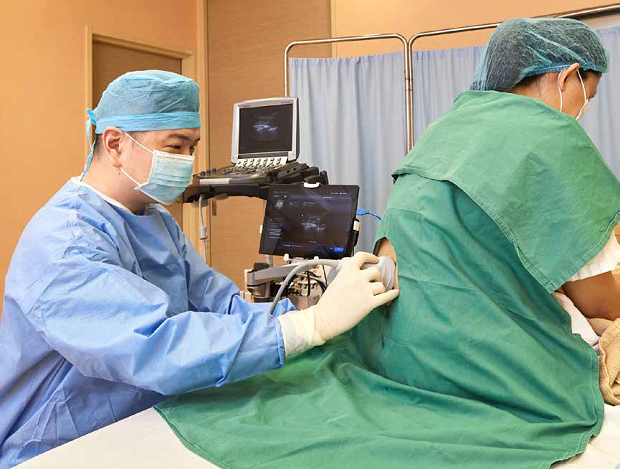
The development of the novel technology, led by KK Women’s and Children’s Hospital, can potentially reduce the risks of neuraxial anaesthesia used in many obstetrical and gynaecological procedures.
Women going through a caesarean delivery usually undergo neuraxial anaesthesia, which is a type of regional anaesthetic procedure that numbs the lower part of their body. It blocks sensations of pain but allows mothers to be awake during their baby’s birth.
At KK Women’s and Children’s Hospital (KKH), about 2,500 spinal anaesthesia procedures have been performed on women undergoing caesarean sections annually, in the last three years.
Spinal anaesthesia involves inserting a needle at a specific point in the lower back, before injecting the anaesthetic drug into the fluid space surrounding the spinal canal.
It is one form of neuraxial anaesthesia performed for surgical procedures, such as caesarean sections, labour epidural analgesia, and some gynaecological surgeries.
While spinal anaesthesia is usually safe, precision is critical as even a slight inaccuracy during the needle insertion carries a potential risk of complications.
Difficulty in needle placement can lead to higher rate of complications, such as multiple attempts needed to locate the landmark, failed anaesthesia, or neurological injury. Other complications include abnormal sensations to the skin, such as tingling or prickling, due to nerve irritation and blood collection within the tissues in the spine.
Associate Professor Sng Ban Leong (below), Head and Senior Consultant, Department of Women’s Anaesthesia, KKH, said that the conventional method of manually identifying the spot to insert the spinal needle requires good knowledge of the anatomy and skills due to its complexity.

“It becomes more challenging in patients who are obese, have an abnormal spine, or have had spine surgery, as patients in these groups would have surface landmarks that are difficult to locate or have no palpable landmarks. At times, repositioning will be required before another needle insertion attempt can be made. Multiple needle insertions increase the risk of the procedure,” he said.
However, a new artificial intelligence (AI)-powered technology developed by KKH in collaboration with the National University of Singapore (NUS) is set to change that.
Called uSINETM, it is the world’s first software that uses ultrasound imaging and AI to automatically pinpoint the exact anatomical landmark on the patient’s spine in which the needle should be inserted during an ultrasound scan.
During the ultrasound scan, the proprietary machine learning algorithm alerts the anaesthetist in real-time when the right spot and angle are identified. Precise needle insertion at first try will enhance patient care by improving the quality of the anaesthesia, and reducing pain and risk of potential complications.

High success rate
A clinical study led by KKH evaluating the first-attempt success rate of spinal anaesthesia procedure using uSINETM has yielded promising results. Between May 2016 and May 2017, 100 women undergoing spinal anaesthesia for surgical procedures at KKH were evaluated. Currently, there is an ongoing clinical trial to evaluate its use in obese patients who have more difficult spinal landmarks.
With uSINETM, the success rate for needle insertion at first attempt during spinal anaesthesia was high at 92 per cent. This is significantly higher than the global first-attempt success rate of 50 to 60 per cent. Prof Sng, who is also the study’s senior author, said that uSINETM could potentially be used in other obstetrical and gynaecological procedures, and not just for caesarean sections.
These include epidural anaesthesia for natural deliveries, which is another common neuraxial anaesthesia procedure. The needle insertion point for an epidural is similar to that of a spinal anaesthesia.
“Neuraxial anaesthesia has its advantages over general anaesthesia, as there is a reduction of drug exposure in the blood stream, less risk of sedation and low breathing in the mother and baby, as well as participation of the mother in the childbirth and delivery process,” he said.
“Worldwide, we know that neuraxial anaesthesia is used in many obstetrical and gynaecological procedures. As the largest maternity hospital in Singapore, we want to improve the care for our patients in this area, and uSINETM will enable this,” Prof Sng said.
“It not only reduces the anxiety, discomfort and pain caused by multiple needle insertions, but also the complications associated with them. Furthermore, this novel AI-powered system may also play a role in training doctors specialising in anaesthesia to better identify correct spinal landmarks.”
Check out KK Women and Children’s Hospital complete pregnancy guide – week 1 to 40 here.
How uSINETM works
During the procedure, the patient sits and bends forward, with the lower back exposed. The doctor places the ultrasound probe at the base of the spine, also called the sacrum.
The AI-powered software programme, which is integrated with the ultrasound machine, guides the doctor to identify the correct space for the needle insertion. It only gives instructions when all the anatomical landmarks are identified for the doctor to insert the needle to deliver the spinal anaesthesia.
The team is looking at enhancing the AI-powered system and investigating the use of the system in high-risk patients. Additional stages of research, trial and approval are required before uSINETM can be accepted as a standard part of care during neuraxial anaesthesia.
Get the latest updates about Singapore Health in your mailbox! Click here to subscribe.













 Get it on Google Play
Get it on Google Play